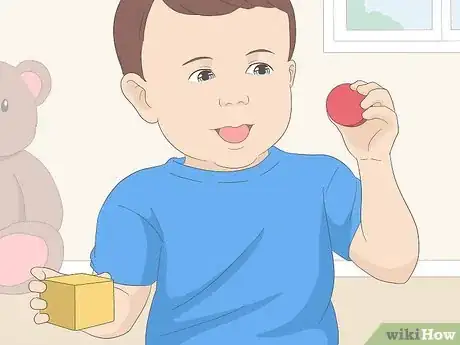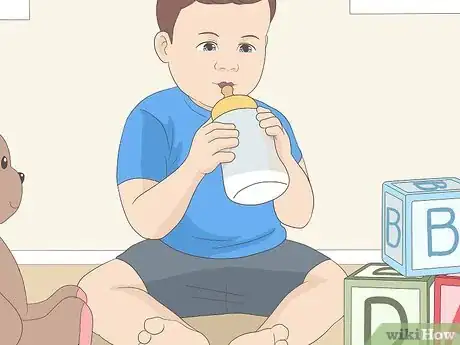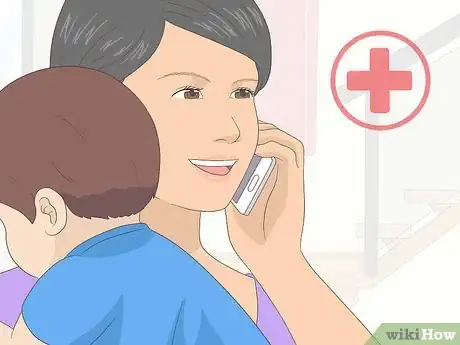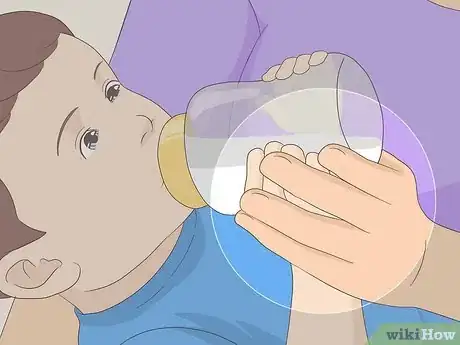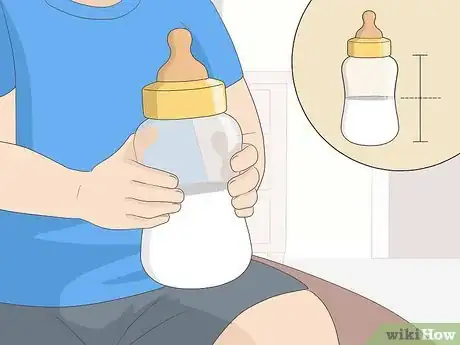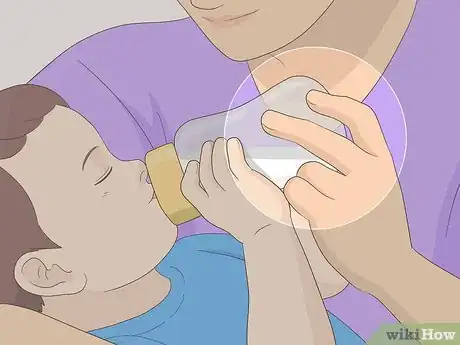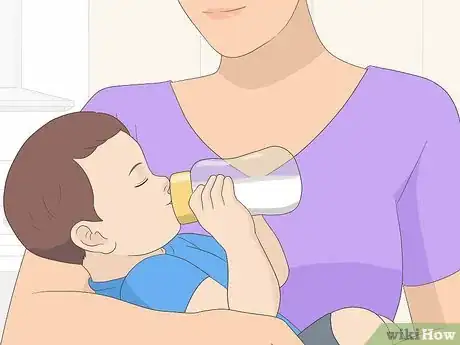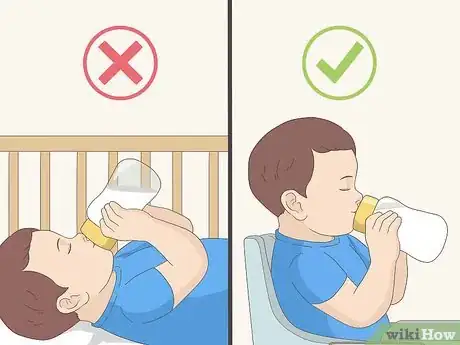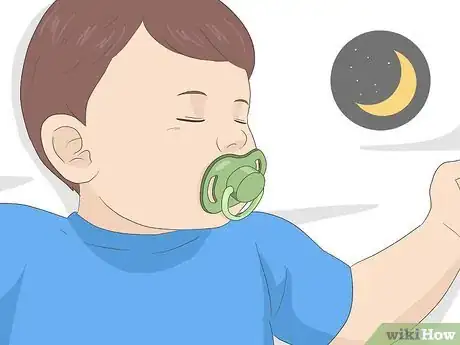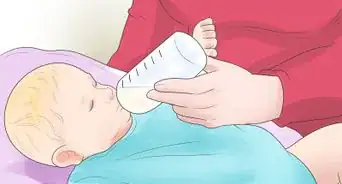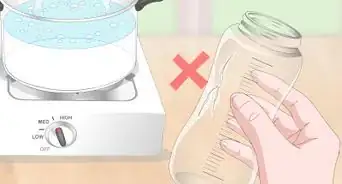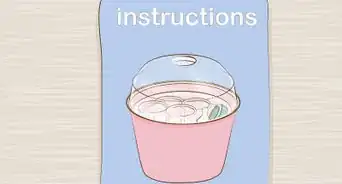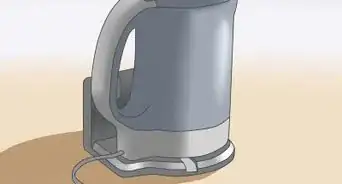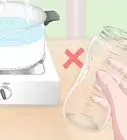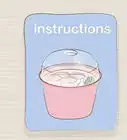This article was co-authored by wikiHow Staff. Our trained team of editors and researchers validate articles for accuracy and comprehensiveness. wikiHow's Content Management Team carefully monitors the work from our editorial staff to ensure that each article is backed by trusted research and meets our high quality standards.
There are 9 references cited in this article, which can be found at the bottom of the page.
wikiHow marks an article as reader-approved once it receives enough positive feedback. In this case, 87% of readers who voted found the article helpful, earning it our reader-approved status.
This article has been viewed 195,613 times.
Learn more...
Self-feeding with a bottle is a major milestone for babies, but it’s important not to rush it. Holding and feeding your baby helps you bond with them, so even if your baby can hold their own bottle, they may resist it. Gauge your baby’s readiness based on their age, other motor skills, and reaction to being given a bottle to hold. If you have any concerns about your baby’s motor skills, consult with your child’s pediatrician. If your baby seems ready to hold their bottle, encourage them gradually. Also, make sure to avoid doing anything that might be unsafe for them, such as leaving them unattended or propping their bottle up.
Steps
Checking for Readiness
-
1Wait until your baby is at least 6 months old. Most babies will not be ready to hold a bottle on their own until they are at least 6 months old. If your baby is younger than 6 months, wait until they are a little older. Some babies don’t develop this skill until much later, such as around 10 to 12 months.[1]
- Keep in mind that all babies are different, so they develop skills at their own pace. Allow your baby to take the lead and do what they’re ready to do.
-
2Watch to see if your baby grasps objects and holds them in one hand. These motor skills may indicate that your baby is capable of holding their bottle. If your baby is not yet doing these things, then they probably won’t be ready to hold their own bottle. However, if your baby is grasping objects and holding them in one hand, they might be ready for self-feeding.[2]
- Your baby may also transfer objects from one hand to the other if they’re ready to hold their own bottle.
Advertisement -
3Place the bottle in your baby’s play area to see if they pick it up. If your baby is uninterested in holding their own bottle, then they might not be ready for self-feeding. If your baby picks up the bottle and brings it to their mouth, then they might be ready to try self-feeding.
- Try leaving the bottle empty or filling it only partway to avoid having a mess in your child’s play area.[3]
Safety Precaution: Never place a bottle into your baby’s crib with them or allow them to crawl or walk around with a bottle in their hand or mouth.[4]
-
4Consult your child’s pediatrician if you are concerned. If you have any concerns at all about your baby’s motor skills, make an appointment with your baby’s pediatrician. They can evaluate them to see if they are developing normally.[5]
- For example, if your baby is not grasping objects at 6 months, then you might consult with your child’s pediatrician to ensure that everything is okay.
Encouraging Self-Feeding
-
1Guide your baby’s hands to the sides of the bottle while you hold them. Hold your baby as you normally would for a feeding and hold out the bottle for them. If your baby doesn’t reach out for the bottle on their own, gently place 1 or both of their hands on the sides of the bottle to show them how to grasp it. Then, guide the bottle towards your baby’s mouth and feed them as usual.[6]
- If your baby doesn’t want to hold onto the bottle, don’t force them. They may not be ready for self-feeding.
- Holding your baby is the best way to encourage them to hold their bottle since they will still get to enjoy snuggling with you.
Tip: Wait until your baby is hungry before you try to get them to self-feed. Watch for cues that your baby is hungry, such as turning their head from side to side and sucking on their hand or a toy.[7]
-
2Start with a partially full bottle to get them used to the weight. A full bottle might be too much for your baby to hold on their own, especially if they have progressed to 6 fl oz (180 mL) or more per feeding. Try filling a bottle halfway and offer it to your baby to see if they can support the weight.[8]
- Make sure to refill the bottle as needed to give your baby their usual amount of breast milk or formula.
-
3Support the weight of the bottle while your baby holds it. Your baby might need your help while they’re getting the hang of holding their own bottle, support it with your hand and adjust the position as needed to ensure that your baby is getting the contents of the bottle and not just air.[9]
- For example, you might need to help your baby tilt the bottle upwards and hold it in a tilted position while they hold it to ensure that they’re getting fluids from it.
-
4Continue to cuddle your baby during some feedings. Don’t stop holding your baby once they can feed themselves with their bottle. Even if your baby has mastered holding their own bottle, it’s important to continue to hold them and cuddle them regularly for their emotional well-being. Choose a few feedings each day when you can sit and hold your baby while they feed.[10]
- For example, you could continue to hold them for feedings at bedtime, first thing in the morning, and before naps.
Keeping Your Baby Safe
-
1Supervise your baby's feedings even if they can self-feed. No matter how confident you are in your baby’s ability to self-feed, it’s still important to supervise them during feedings. Stay in the same room as your baby and ensure that you can see and hear them. This way you will notice if your baby falls asleep and begins to choke or if they need your help.[11]
Tip: If you’re unable to watch your baby, ask a member of your household, such as your partner or the baby’s grandparent to supervise them while you are occupied.
-
2Keep your baby sitting upright or at a slight incline while they feed. Don’t allow your baby to feed flat on their back. Milk can get into their Eustachian tubes if they feed in this position and this may lead to an ear infection. Always hold or position your baby so they are sitting upright or leaning back at a 45 degree angle.
- For example, you could hold your baby in your arms and keep them angled so that their head is above their stomach. Or, you could place your baby into a high chair or their stroller with the seat in the upright or inclined position.
-
3Switch to a pacifier at bedtime to prevent tooth decay. Breast milk or formula can pool around your baby’s teeth and lead to cavities at a very young age if your baby feeds until they fall asleep. To prevent this, switch to a pacifier before your baby has drifted off completely. Your baby can suck on the pacifier as they’re falling asleep and continue to suck on it while they sleep as well.[12]
- As an added bonus, giving your baby a pacifier at bedtime reduces the risk of Sudden Infant Death Syndrome (SIDS).[13]
Warnings
- Never prop up your baby’s bottle to feed them if they are not able to hold it themselves. This can lead to overfeeding and choking.[14]⧼thumbs_response⧽
References
- ↑ https://www.babycenter.com/baby/formula-feeding/when-can-my-baby-hold-his-own-bottle_1368471
- ↑ https://kidshealth.org/en/parents/development-9mos.html
- ↑ https://indianexpress.com/article/parenting/family/how-to-help-baby-hold-bottle-while-feeding-5784505/
- ↑ https://nrckids.org/CFOC/Database/4.3.1.8
- ↑ https://www.parents.com/baby/development/how-can-i-help-my-9-month-old-son-to-hold-his-own-bottle/
- ↑ https://indianexpress.com/article/parenting/family/how-to-help-baby-hold-bottle-while-feeding-5784505/
- ↑ https://nrckids.org/CFOC/Database/4.3.1.8
- ↑ https://indianexpress.com/article/parenting/family/how-to-help-baby-hold-bottle-while-feeding-5784505/
- ↑ https://www.thebump.com/a/when-do-babies-hold-their-own-bottle
- ↑ https://www.healthychildren.org/English/ages-stages/baby/feeding-nutrition/Pages/Practical-Bottle-Feeding-Tips.aspx
- ↑ https://indianexpress.com/article/parenting/family/how-to-help-baby-hold-bottle-while-feeding-5784505/
- ↑ https://www.healthychildren.org/English/ages-stages/baby/feeding-nutrition/Pages/Practical-Bottle-Feeding-Tips.aspx
- ↑ https://www.scientificamerican.com/article/pacifier-greatly-reduces/
- ↑ https://www.babycenter.com/baby/formula-feeding/when-can-my-baby-hold-his-own-bottle_1368471
About This Article
Getting your child to hold their own bottle doesn't have to be hard, especially if you practice at the right time. When they’re between 6 and 10 months old, encourage them to hold the bottle with you when you feed them. You can also try giving them an empty bottle to hold by themselves, which will allow them to practice without the extra weight of the milk. If you think your baby is ready to hold a full bottle by themselves, make sure that they’re sitting up with their head higher than their feet. This is important because feeding while lying down can cause infection. Turn off all bright lights or other distractions, since you want them to focus solely on holding the bottle. If they manage to hold it, support their arms with your hand so they don’t have to bear the weight all of the time. For tips on how to tell if your baby is ready to hold their own bottle, read on!

